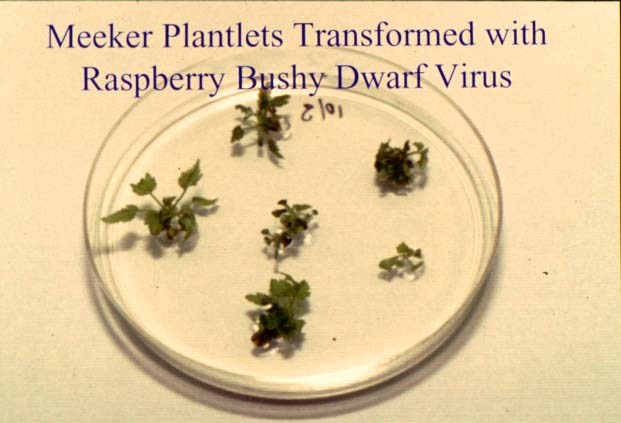Figure 9
RBDV Management
Resistant CultivarsThe best way to avoid infection from the RBDV type strain is to plant immune or resistant cultivars (Figure 10). There are several red raspberry cultivars available that are immune or resistant to the type strain of RBDV from both North America and Europe. Unfortunately, these are often unable to match the yield and quality of many RBDV susceptible cultivars. In addition, the RB strain of the virus in Europe overcomes the resistance conferred by the gene Bu.
Figure 10
Site selection
Since the virus is pollen-borne, replanting large blocks should reduce the rate of virus infection by slowing down the transmission of virus infected pollen into the field. Most bees working the field will then be visiting plants free of RBDV and relatively little pollen from infected plants will be introduced. Planting raspberry fields that are isolated from other raspberry plantings also aids in reducing inoculum sources.
:
Figure 11
Only certified virus-free stock should be planted. Tests of fields during the planting year showed that the material coming from the nurseries was free of RBDV, infections were not found in newly planted fields. Floricane fruiting raspberries do not flower on first year canes. Canes are produced one year and those canes flower and produce fruit the following year. Thus, there are very few flowers in these fields the planting year. Virus was not detected in newly planted fields until after the first bloom which was a year after planting. Virus incidence in fields in the Fraser Valley went from 0%, 0% and 2.3% to 17%, 53% and 83% in three separate fields between 1996 and 1998. In contrast, three fields in southern Washington and Oregon that had 0%, 4% and 5.6% in1996 did not show an increase in incidence of RBDV in 1998. The reason for the dramatic difference in rates of increase is unclear, but could be due to environmental differences. In the Fraser Valley the raspberry production is in a coastal area whereas in southern Washington and Oregon the production is separated from the coast by a mountain range. The climate in this southern area is warmer and drier during bloom.
Transgenic Plants
Work is currently underway to engineer pathogen derived resistance to RBDV in popular red raspberry cultivars. Pathogen derived resistance makes use of pathogen genes inserted into the host plant which subsequently interferes with the virus life cycle. Currently, coat protein, mutated movement protein, mutated polymerase and nontranslatable RNA are all being investigated as means of developing resistance to RBDV (Figure 11 and 12). It will still be several years before any transgenic raspberries will be available to growers.


